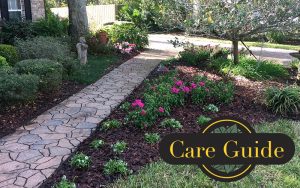
Landscape Aftercare Guidelines
Click Here to view or download this guide as a PDF.
DIY Landscape Aftercare Guidelines
WATERING
As of 2018, the SJRWM District, Duval County, St. John’s County and the Beaches Municipalities all allow you to water your new landscape with an irrigation system every day for 30 days, and then every other day for the next 30 days as long as you do so between 4:00PM and 9:00AM. Hand watering and low volume watering (such as drip, micro-irrigation and the use of soaker hoses) are permitted at any time. Once a regular schedule can be established, watering is best done in the morning to avoid fungal problems.
In general, most plants need to be watered every day for 2-4 weeks after planting. A good general post-planting watering schedule is as follows: week 1 and 2 every day, week 3 and 4 every other day, week 5 and 6 every third day, then 2 times per week or what is allowed by law. Fall/Winter plantings usually don’t require as much water as summer plantings and can receive water in weeks 1 and 2 every other day, weeks 3 and 4 every third day, weeks 5 and 6 twice weekly then once weekly or what is allowed by law.
If you are going to rely on irrigation systems, please make sure all plants are receiving adequate coverage. The spray/pop-up zones should be set for at least 15-25 minutes per cycle and rotor zones should be set for 45-60 minutes. These are guidelines. Both duration and frequency of watering depend on site specifics such as sun and wind exposure, current rainfall, weather patterns and whether the site is naturally wet or dry. We will be happy to help you determine adjustments. We also suggest that even those who rely on irrigation for most of their watering needs should try to hand water new plantings at least once or twice a week for the first month. This ensures that you will notice any decline, water deficiencies or stresses in the plant material before it is too late.
Large trees and shrubs (15 gal and over) should be given water by hand supplemental to the irrigation system. A good rule of thumb is to give the plant the amount of water equivalent to approximately half the pot size (i.e. 5-7 gal for a 15 gal tree). The need for this watering can also be met by installing a bubbler on individual trees, which can be done by Rockaway at your request for an additional charge.
STAKING
More damage can actually be done by improper staking than by not staking at all. The goal of staking is mainly to support the root ball, not the trunk. Wind movement is important to help the tree develop ta-per from the bottom of the trunk to the top, strengthen the trunk and promote root development. Only stake when the top growth massively outweighs the root ball, where the soil is very sandy or there are strong winds such as in very open sites. Another time to stake is if you can move the trunk back and forth and create a hole in the soil around the base of the tree. In-ground stakes can be attached to 2 horizontal pieces that lie on the ground parallel to each other and crossing the root ball. This stabilizes the root ball without creating any damage to the trunk. Alternatively, the tree can be tied at three points off of stakes with slightly elastic ties and attaching at several points along the trunk. Most trees should remain staked for 6 months to a year depending on their size, rate of growth and the current season. Here at Rockaway we sell an inexpensive kit with the best components for staking.
FEEDING
In general most plants benefit from regular applications of plant food. Feb/March, May and September are great months to feed most plants. Others require specific types of food in certain seasons or at regular intervals. For instance, citrus should be fed with citrus food at least four times a year between March and October, depending on the age of the tree. Azaleas, camellias and gardenias also benefit from specific foods with high acid content usually during the growing season. If you use compost and/or planting mix and organic fertilizer when planting, then no additional fertilization should be needed within the first month. Roses are the only exception to this rule and will benefit from a liquid fertilization about two weeks after installation. We have separate care handouts for citrus and roses.
PRUNING
Most new plants should not be pruned for at least one month after planting.
COLD TOLERANCE
To achieve a desired effect, tropical or half hardy plants are sometimes used. These plants, such as crotons, hibiscus, and Ti plants, benefit from the application of frost cloth or blankets when the temperature is forecast to drop below 32 degrees for more than 4 hours. Young citrus trees also benefit from being covered during a freeze. Some plants, although hardy, do tend to get brown leaves after a frost. Commonly used plants that will die back and return after a hard freeze are variegated flax lily and variegated ginger. These plants should be trimmed back only after the last chance of frost has passed. If cut back too early, the plant can be stimulated to grow during one of our winter’s frequent mild spells, only to be hit by frost again—which can lead to death of the plant.
Rockaway provides Maintenance Service plans on an on-going or as-needed basis, tailored to your turf, gar-dens, seasonal color, flower beds, lighting and irrigation needs. You can also call us with any questions or concerns you may have about your landscape.
Gardening success depends on many factors and problems can arise unique to your situation. Guidelines can be open to interpretation. If you need additional information, we would be happy to help.
